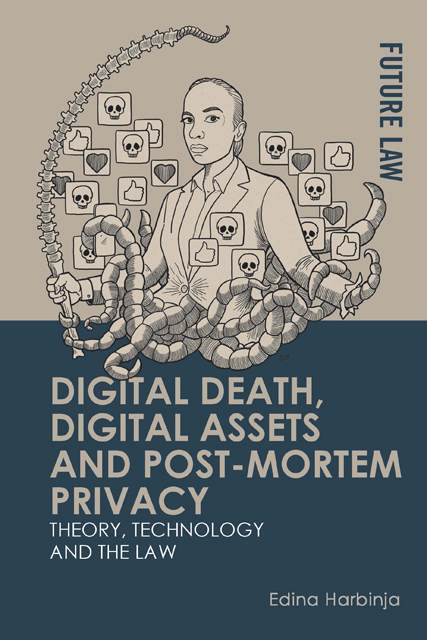Book contents
- Frontmatter
- Contents
- Acknowledgements
- Table of Cases
- Table of Legislation
- 1 Introduction
- 2 Theoretical Underpinnings: Property
- 3 Theoretical Underpinnings: Autonomy, Testamentary Freedom and Post-Mortem Privacy
- 4 Social Networks
- 5 Games, Virtual Worlds and Virtual Realities
- 6 Emails
- 7 Conclusion
- Bibliography
- Index
7 - Conclusion
Published online by Cambridge University Press: 25 April 2023
- Frontmatter
- Contents
- Acknowledgements
- Table of Cases
- Table of Legislation
- 1 Introduction
- 2 Theoretical Underpinnings: Property
- 3 Theoretical Underpinnings: Autonomy, Testamentary Freedom and Post-Mortem Privacy
- 4 Social Networks
- 5 Games, Virtual Worlds and Virtual Realities
- 6 Emails
- 7 Conclusion
- Bibliography
- Index
Summary
Possible solutions for the issues identified in previous chapters will be grouped loosely into technology and market solutions, followed by legal and policy solutions, reflecting Lessig’s taxonomy of the four regulatory modalities of cyberspace: ‘code’ (i.e. technology and architecture), market, law and norms.
The main idea advanced in this book is that the interests of individual users to decide what happens to their data on death should be recognised and protected. In other words, the book promotes user autonomy, privacy, identity and technological options that correspond with the offline, traditional ones (i.e. freedom of testation). The solutions also recognise novel phenomena of immortality, considered under the concept of postmortal privacy. This is not to say that some other legitimate interests should be disregarded, such as public interest, the need to maintain archives and historical records, freedom of expression or the freedom to conduct business. However, due to the scope of this book, an in-depth examination and balancing of these interests is not viable.
All these solutions are tentative. They originate from the analysis in this book, and I will aim to develop further the principles established here in future research projects and publications. The ambition of this book was to set the scene, introduce and explore critical theoretical and legal issues, and offer a framework for future thinking, rather than to offer precise solutions for each issue.
7.1 ‘Code’ and Market Solutions
‘Code’ or technology solutions, using Lessig’s taxonomy mentioned above, are online services aiming to assist in the disposition of digital assets on death, digital estate planning, succession and remembrance. A significant category of stakeholders is online services, which aim to help with the disposition of digital assets on death. They aim to shift the control of digital assets to users by enabling the designation of beneficiaries who will receive the passwords and content of digital asset accounts. This way, the services impliedly recognise user property in digital assets and attempt to bypass restrictions imposed by the terms of service discussed in this book. Understandably, they also see a growing market and an opportunity for investment and profit.
These services, still primarily US-based but increasingly hosted in the UK, are categorised in this book as follows:
• Digital wills, for example Legacy Locker, now part of the True Key service, Cirrus Legacy, Beyond Life or SecureSafe.
- Type
- Chapter
- Information
- Digital Death, Digital Assets and Post-Mortem PrivacyTheory, Technology and the Law, pp. 204 - 215Publisher: Edinburgh University PressPrint publication year: 2022



